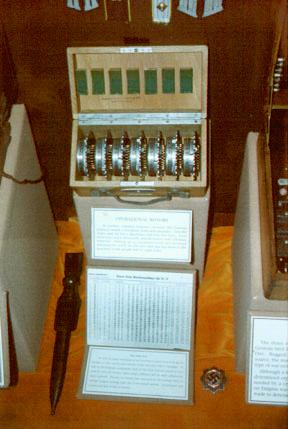
| HOMEPAGE | ALAN TURING | ENIGMA CODE | CODES AND CYPHERS | BLETCHLEY PARK |
NAVAL ENIGMA
The first wartime naval
Enigma machine (M3) was identical to the model used by the German Army
and Air
Force, but it was
issued with additional rotors, VI, VII and VIII, which were reserved for
the Kriegsmarine (German Navy). However, the Kriegsmarine also employed
codebooks to shorten signals as a precaution against shore high-frequency
direction-finding, and some manual ciphers. The most important codebooks
were the Kurzsignalheft (short signal book) for reports such as sighting
convoys, and the Wetterkurzschlüssel (weather short signal book) for
weather reports. M3) was identical to the model used by the German Army
and Air Force, but it was issued with additional rotors, VI, VII and VIII,
which were reserved for the Kriegsmarine (German Navy). However, the Kriegsmarine
also employed codebooks to shorten signals as a precaution against shore
high-frequency direction-finding, and some manual ciphers. The most important
codebooks were the Kurzsignalheft (short signal book) for reports such
as sighting convoys, and the Wetterkurzschlüssel (weather short signal
book) for weather reports.
Naval Enigma signals
used different ciphers, each with its own daily key (rotor order, ring
settings, plugboard connections and ground setting). The principal cipher
was Heimisch (Heimische Gewässer - known to Bletchley Park as
Dolphin) for U-boats and surface ships in 'Home Waters', including the
Atlantic. At least 14 other naval Enigma ciphers were used later in the
war.
Most ciphers had Allgemein
(general) and Offizier keys. Offizier signals were first enciphered using
the plugboard connections from monthly Offizier keylists. The complete
message was then enciphered a second time using the Allgemein key. A few
ciphers also had Stab (Staff) keys, which were also doubly enciphered,
but had their own special settings. Offizier signals often took a week
or more to break at Bletchley.

The German Navy used two different methods to conceal the message setting from an interceptor.
a) the Enigma machine itself.
A message setting,
chosen by the operator, was enciphered twice on the Enigma machine starting
from the Grund and the resultant
letters transmitted
to the intended recipient in a header to the message.
b) a completely separate coding system
On May 1st 1937 the German Navy introduced a new indicating system, the bigram substitution.
This was the main Naval
system and involved selecting a trigram from a book (the Kennbuch, or K
Book), enciphering this at the
Grund to get the message
setting, then performing a bigram substitution on the trigram and then
transmitting the result as a header
to the message.
The intended recipient
then performed the inverse bigram substitution to recover the trigram then
enciphered this at the Grund to
get the message setting.
In order to understand,
why it was so difficult to break Naval Enigma, let's take a look to a Daily
Key
1. The Wheel Order (WO).
The numbers
of the wheels to be placed in the Enigma machine from left to right.
( 336 possible
from eight wheels).
2. Ringstellung,
(Tyre or Ring
setting) for each wheel, left to right.( 17,576 combinations ).
3. Stecker,
or plug-board connections.
Usually ten pairs involving 20 letters.( 140 million million ).
4. The Grundstellung (Grund).
The three (or four) letters showing the position of the wheels to be used for enciphering the message setting.
single Grund on right hand side.
The main Enigma ciphers used by the U-boats are listed
below.
The Bletchley codename
for a cipher is given first, with the Kriegsmarine name in brackets.
Dolphin (Heimische Gewässer, later Hydra)
Dolphin came into service at the beginning of the war. It was used by all
U-boats (and ships) in "home waters"
(an area which included the Atlantic) until 5 October 1941 (see Shark).
Bletchley broke Dolphin from 1 August 1941 until the end of the war.
Shark (Triton)
Used by the Atlantic and Mediterranean U-boats from 5 October 1941. Introduced
because of fears about
security, especially the threat from the British Secret Service, which
was highly (but overly) respected by the
Kriegsmarine. Shark used three-rotor Enigma (M3) until 1 February 1942,
when it switched to the four- rotor
version (M4).
Bletchley broke Shark in M3 form. The M4 version was only broken on three
days before 13 December 1942.
From then until the end of August 1943, it was generally broken, but quite
often late. From September 1943
onwards, Shark was normally broken within about 24 hours.
Turtle (Medusa)
Used by the Mediterranean U-boats from June 1943 to October 1944. Turtle
was broken from June 1943
onwards.
Narwhal (Niobe)
Used by the Northern U-boats (based in Norway) from 25 June 1944 to the
end of the war. Narwhal was broken
from September 1944.
[No British name] (Thetis)
The cipher for U-boats on tactical training exercises in the Baltic. Thetis
was never broken.
Grampus (Poseidon)
Used by U-boats in the Black Sea from October 1943 to August 1944. Grampus
was broken from October
1943.
Sunfish (Tibet)
Used by supply ships and U-boats in the Far East from September 1941. Sunfish
was intermittently broken
from August 1943.
Other naval Enigma ciphers
These included:
Barracuda (Neptun)
The cipher for fleet operations. Barracuda was used from May 1941. It was
never broken.
Bonito (Eichendorff)
Used by the Small Battle Units Command (which covered midget submarines,
such as Marder and Seehund)
from March 1944 to the end of the war.
Bonito was first broken in May 1944, and generally solved from July 1944.
|
|
|
|